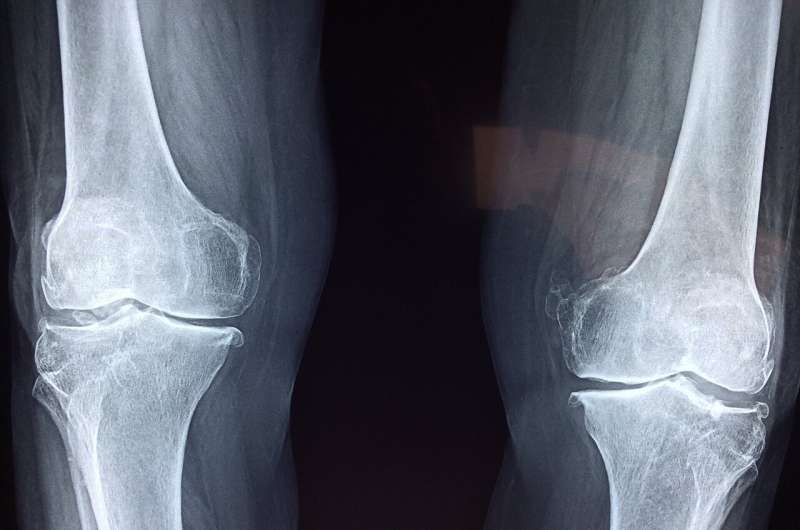Gallic acid and stretching decrease osteoarthritis markers in cartilage cells

A healthy diet and a little exercise appear to be good for arthritis, even on the cellular level.
A team led by Washington State University researchers used gallic acid, an antioxidant found in gallnuts, green tea and other plants, and applied a stretching mechanism to human cartilage cells taken from arthritic knees that mimics the stretching that occurs when walking. The combination not only decreased arthritis inflammation markers in the cells but improved the production of desired proteins normally found in healthy cartilage.
While still at an early stage, the findings suggest a new procedure could be developed to treat cartilage cells extracted from a patient to grow a supply of cells or a tissue to be re-implanted.
"We found the combined stretching, which acts like an exercise for the cell itself, with the gallic acid decreased inflammation markers, which means we were able to reverse osteoarthritis," said Haneen Abusharkh, the study's lead author and a recent WSU Ph.D. graduate. "It's basically like having good exercise and a good diet on a micro-scale."
For the study, published in Experimental Cell Research, the researchers harvested osteoarthritic cartilage cells from donated knees taken out during joint replacement surgery at Pullman Regional Hospital. They cultured the cells in the lab and first tested six antioxidant "nutraceuticals," or nutritional products, including Vitamin C, Vitamin E and curcumin. Antioxidants can neutralize free radicals, unstable atoms that result from oxidative stress which can damage cells and tissues.
The laboratory tests suggested gallic acid as the most effective antioxidant for neutralizing the free radicals in the osteoarthritic cartilage cells. The researchers then applied the gallic acid and added stretching, using a cytostretcher developed by the company Curi Bio Inc. They set stretching to 5%, a level that matches the stretch in human knees when walking.
The combination decreased inflammation markers known as matrix metalloproteinases. It increased the deposition of collagen and glycosaminoglycans, which are compounds that give connective tissue its integrity, tensile strength and resistance to compressive forces from body weight on the joints. The stretching and gallic acid also increased the expression of two other cartilage-specific proteins.
Osteoarthritis, the most common musculoskeletal disorder in the world, destroys cartilage in joints causing pain and limiting movement. As of yet there is no complete cure, and treatments range from prescribing pain killers to replacing the joint surgically with a synthetic one, but even the surgery does not allow the patient to return to a full range of motion.
Another procedure is called autologous chondrocyte implantation, or ACI, which involves removing cartilage cells from the joint, growing them to large numbers and then re-implanting them. Currently, the cells are not treated before re-implantation, the researchers noted, and the lack of treatment results in cells growing a weaker fibrocartilage. They can also remain affected by osteoarthritis, and these procedures do not return full functionality to the joint. This study shows a potential way to develop a similar procedure by first treating the cartilage cells while growing them into a tissue that could then be re-implanted.
"We are advancing techniques to make regenerative cartilage in the laboratory that could potentially be implanted into cartilage lesions, so that joint replacements would decrease in number," said Bernard Van Wie, WSU professor in the Voiland School of Chemical Engineering and Bioengineering and the study's principal investigator and corresponding author. "We're looking to develop a natural cartilage that works properly from the beginning, rather than replacing the joint."
The study adds evidence that it may be good to eat foods high in antioxidants—and to exercise, although the researchers caution that gallic acid should not be seen as a miracle cure, and any course of action should be taken only in consultation with a person's doctor.
"This provides some evidence that a good diet and an exercise actually work," said Abusharkh. "Even for people who have mild osteoarthritis, it's really good to exercise. It's very bad for our cartilage tissue to just lay down or sit the whole day; we have to have a little bit of activity."
More information: Haneen A. Abusharkh et al, Combining stretching and gallic acid to decrease inflammation indices and promote extracellular matrix production in osteoarthritic human articular chondrocytes, Experimental Cell Research (2021). DOI: 10.1016/j.yexcr.2021.112841





















